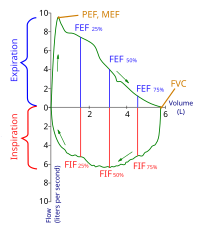
Photo from wikipedia
OBJECTIVE Assessment of intravascular volume status to ensure optimization before hospital discharge could significantly reduce readmissions. It is difficult to evaluate congestion on clinical signs during an episode of acute… Click to show full abstract
OBJECTIVE Assessment of intravascular volume status to ensure optimization before hospital discharge could significantly reduce readmissions. It is difficult to evaluate congestion on clinical signs during an episode of acute heart failure (ADHF) in elderly patients. HYPOTHESIS There is an association between various volume overload parameters in patients older than 75 years. METHODS We performed a single-center prospective longitudinal study of patients older than 75 years hospitalized for acute heart failure. We analyzed the association between congestion assessment based on clinical signs, inferior vena cava (IVC) diameter measured by ultrasound, biological evaluation with N terminal pro brain natriuretic peptide (NT-proBNP), and estimated plasma volume (EPV) during decongestive therapy. We also monitored changes in renal function. RESULTS Fifty consecutive ADHF patients (85.2 ± 5.9 years, 68% female) were included in the study. At admission, a dilated, noncompliant IVC was found in all patients. The strongest correlations between different parameters of volume overload estimation were found between IVC and jugular vein distention (r = .8; p < .001), then IVC and oedema (r = .6; p < .001), IVC and crackles (r = .3; p < .036), then IVC and NT-proBNP (r = .3; p = .02). There was no correlation between EPV and signs of congestion. Patients who had no congestive signs on clinical or IVC examination at Day 2, more often presented with acute renal failure. CONCLUSION In ADHF patients older than 75 years, clinical and IVC evaluation of intravascular congestion correlate well. The concomitant assessment of clinical signs and IVC may prevent depletion-related renal failure.
Journal Title: Clinical cardiology
Year Published: 2022
Link to full text (if available)
Share on Social Media: Sign Up to like & get
recommendations!